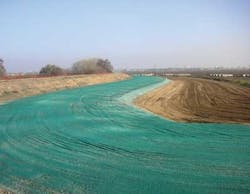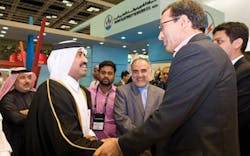Examining Nanotechnology for Recovery of Phosphorus
By Edward Weinberg, Tito Viswanathan, Chris Finlay and Sunil Kumar
In the last 50 years, the concentration of phosphate entering the water system has increased at an alarming rate, causing a significant water quality problem across the United States. An urgent need exists for improved methods of removing phosphorus from point sources, such as waste water treatment plants, and run off from agricultural farms and urban areas.
Both of these sources contain high amounts of phosphorus as phosphates from biotic (animal wastes) and abiotic (lawn and farm fertilizers) sources that end up in water reserves causing eutrophication. An Executive Order has been issued to save the severely impaired Chesapeake Bay watershed, and as a result, the USEPA has developed an aggressive Total Maximum Daily Load (TMDL) model (“pollution diet”), which targets the necessary reductions in nitrogen and phosphorus nutrient pollutants to improve water quality and to repair the Bay. In response, individual Bay States have developed Water Implementation Plans that call for reductions of phosphorus discharges by millions of pounds per year through the next decade.
On top of this phosphate discharge water quality problem, nutrient phosphate is a finite resource and current reserves could be depleted this century. Before that point is reached, we will see a global peak in phosphate rock reserves, estimated to occur in the next 30 years. Figure 1 includes a “Peak P” curve modeled in similar fashion to Hubbert’s Peak Oil model and shows actual production numbers and the modeled “peak” where demand outstrips supply (estimated year 2033, Cordell, et al, 2009).
While it is understood that phosphate rock, like oil and other key non-renewable resources will follow a Hubbert production model curve, a key difference between peak oil and peak phosphorus, however, is that oil can be replaced with other forms of alternative or renewable energy once it becomes scarce; Comparatively, there is no substitute for phosphorus in crop production. Phosphorus cannot be produced or synthesized in a laboratory. Quite simply, without phosphorus we cannot produce the food needed to feed an ever growing world population.
One answer to this dilemma is to recover this nutrient for reuse as a fertilizer and other higher value uses. A description of advanced phosphorus nutrient removal and recovery based on iron-oxide adsorption chemistry follows.
When the USEPA changed the health standard for naturally occurring Arsenic in drinking water supplies from 50 µg/L to 10 µg/L, due to health concerns, a water filtration market developed based primarily on iron-oxide’s high sorption capacity for arsenate/arsenite. However, dissolved phosphate is a known interferent that impedes Arsenic adsorption via competition for adsorption sites. Hence, materials or media that contain iron-oxide will adsorb phosphate. The iron-oxide is regenerable, providing lower operating costs through reuse of the media. The resultant regenerant solution is a nearly saturated solution of reactive, bioavailable phosphate fertilizer. The advent of nanotechnology allows for tremendous increases in metal oxide surface area compared to the macro counterpart. This in turn provides the favorable kinetics needed for making phosphate adsorption cost-effective.
Research chemists at the University of Arkansas, Little Rock (UALR), have filed a synthesis patent for the low-cost production of a micro-Carbon aggregated with nano magnetite particles. This new class of nanomaterial is referred to as a nanocomposite (C-magnetite). The source of the carbon substrate is a renewable resource and not a synthetic resin material. A Scanning Electron Microscope photo shows the nano-magnetite (white) particles aggregated within the carbon (larger gray spheres).
The surface area of the UALR nanocomposite is approximately 400 to 450 m2/g. In comparison, Granular Ferric Hydroxide Oxide (FHO) has a surface area of approximately 0.02 m2/g and activated carbon with an Iodine number of 1000 has a surface area of 1000 m2/g but no affinity for dissolved phosphate. The unique property of the nano-magnetite (size range 10 to 60 nanometers [nm]) compared to its macro or bulk counterpart is magnetic strength. Magnetite in nature is a weak magnetic material; at the nano-scale, it becomes supermagnetic. This property can be exploited via the use of magnetic fields or magnetic filters to separate the nanocomposite from the waste stream for reuse/recycle of the nanocomposites or the design of suspended bed, upflow filter columns with minimal pressure drops.
UALR and O’Brien & Gere have done extensive beaker tests using synthetic solutions of phosphate and wastewater samples from a dairy. Commercially available (macro) products for arsenic or phosphate removal were tested along with the nanocomposite. The red bars in Figure 2 represent the nanocomposite results in percent phosphate removed and the other bars represent: Imbrium (macro iron oxide coated sand), Geobind (“red mud”, macro bauxite waste) and a dispersed nano-iron oxide at the surface of a conventional ion exchange synthetic resin. (Layne RT™, labeled TAN 0208 on Figure 2.) Additional testing results of various iron oxides vs. magnetite shown in Figure 3, demonstrate that nanomagnetite is the best performer for phosphate removal. Slight modifications to the nanocomposite synthesis process resulted in the best beaker test results.
Of all of the materials tested, only the C-magnetite nanocomposite suppressed odors emanating from the dairy wastewater samples. This phenomenon infers dual functionality of the nanocomposite: magnetite for P nutrient adsorption and the carbon for odor control. More beaker tests are needed to confirm odor suppression and to develop the odor removal mechanism for optimizing the synthesis blending, i.e., the C-nanomagnetite ratio of the composite for dual functionality.
Comparing the selling price of pure nano magnetite particles to the projected cost to produce the novel nanocomposites shown here is further evidence that UALR has developed a low-cost route to nanotechnology. Pure nano magnetite particles sell for approximately $200 per pound. The projected cost to produce a pound of UALR nanocomposite is less than $4 per pound.
Conclusion
In summary, the most superior test results were achieved with the nano-based materials. Coupled with cost estimates using the nanocomposite as a replacement for chemically enhanced phosphorus removal using alum, the least expensive of the treatment chemicals, these results warrant the next step of evaluation and comparison of the nanomaterials: microcolumn studies. Microcolumn tests will reconfirm the bench-top results and provide critical data for field pilot demonstration, full-scale implementation and full-scale cost estimating - adsorption isotherms, Empty Bed Contact Times, regeneration optimization, etc. - as a commercial, water filtration/adsorber vessel charged with nanomaterials. Representative wastewater samples collected from sewage treatment plants, industrial wastewater facilities, and dairy parlors are planned for the rounds of microcolumn tests.
About the Authors: Edward Weinberg, PE is a Sr. Technical Director for O’Brien & Gere Engineers, E. Norriton, PA. Weinberg has more than 37 years of experience in the environmental and remediation fields, which includes water and air pollution control, groundwater remediation engineering services, and disinfection. Tito Viswanathan is a Professor of Chemistry in the Dept of Chemistry at the University of Arkansas at Little Rock. His research is in the area of chemurgic utilization of renewable resources such as lignin and tannin. Chris Finlay is a senior undergraduate student working under Dr. Viswanathan. His main research focus has been the synthesis and characterization of tannin-based carbon-metal composites and the application of these materials to water purification technologies. Sunil Kumar Ramasahayam is working on his MS in Chemistry under Prof. Tito Viswanathan. His research interests include the synthesis and characterization of metal nanocomposites using renewable resource materials.




